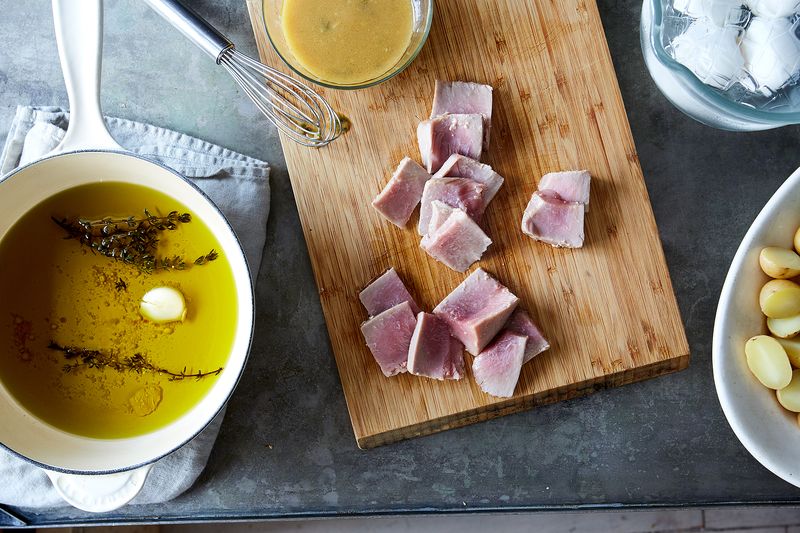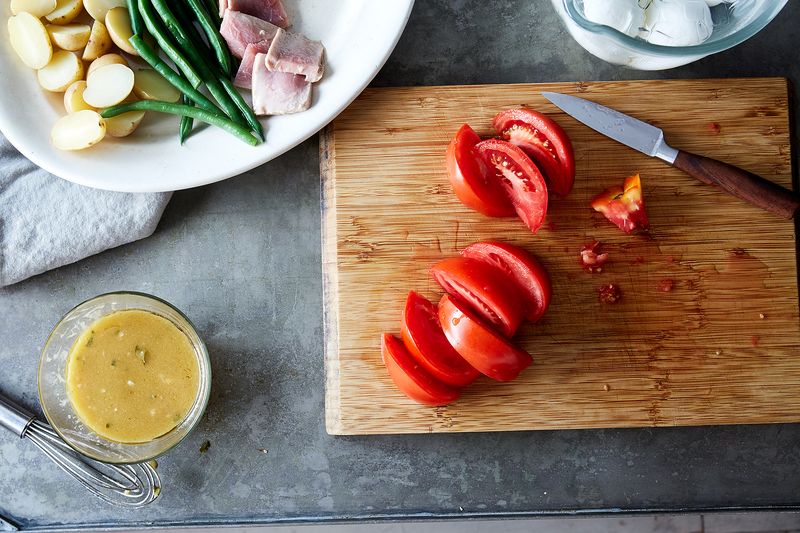Composed salads are immensely satisfying—a little of this, a little of that, arranged tidily on a big platter. They're the sort of thing that invites sharing that big platter with a friend, both of you eating with your fingers. (This is my favorite way to eat anything.)
Chief among les salades composées is the salade Niçoise—which is named after the beachy city of Nice in the south of France, should you need further convincing that this composed salad is, at its best, a relaxed (yet elegant!) finger-food affair. It is sharp and bitey in all the right places, it satisfies the craving for little oily potatoes, and it is fresh and green and hearty and comforting all at once. If there were a starched-but-untucked white button-down of food, it would be the Niçoise.
But what fun is something so tidy if you can't mess it up! Here's how to make—and fuss with—the Niçoise:
Please, Just Give Me the Basics:
- Cook your tuna or other proteins. (This includes eggs.)
- Cook any vegetables—potatoes, green beans, etc.
- Slice tomatoes and any other fresh vegetables; cut or flake the tuna and slice the eggs.
- Make a sharp vinaigrette.
- Arrange the elements on a big platter, scattering with olives, anchovies, and dressing.
- Eat with your hands.
Keep reading for a beyond-the-basics how-to!

Photo by Linda Xiao
The Traditional Niçoise
Reflective of its origins on the sunny French Riviera, salade Niçoise is best at the height of summer, when the tomatoes are luscious and the green beans (or French green beans, haricots verts, if you can find them) snappy and tender. Both are at the salad's core. Though there's much debate about what makes a proper Niçoise, you'll most regularly find the aforementioned tomatoes and green beans/haricots along with little potatoes, anchovies, capers, boiled eggs, and tuna, all drizzled with an un-shy dressing of mustard, vinegar, oil, and tender green herbs—specifically tarragon and chervil.
These are all variables, though. Nix the tomatoes if you're not interested in them. Boil a few more eggs and leave out the tuna if you want a vegetarian salad. It may not be the classic Niçoise, but it's your salad. Do what you want.

Photo by Linda Xiao
If we want to talk about this at its most basic, the foundation of the salad should be very fresh, very simple, very good-tasting produce (i.e. green beans, potatoes, tomatoes) that will be happy served with an aggressive dressing. Luckily, most very fresh, very simple, very good-tasting produce is.
Beyond that, the Niçoise is a salad of "sinkers"—the things that, were this not a composed salad, would find their way to the bottom of the bowl. Here's what that includes (and how to prep them):
- Tuna: Use either the good, oil-packed stuff from a can or poached yourself. I like Amanda Hesser's olive oil-poaching technique.
- Eggs: These ideally should be medium-boiled so that they're still gold and velvety at the center. To do this, put cold eggs in boiling water for 8 minutes, then transfer to an ice-water bath before peeling.
- Anchovies: Two ways! Mash them lightly with a fork and incorporate them into the dressing (use the oil they came packed in in the dressing, too) or fling a couple anchovies over the finished salad. Or both!
- Olives: This is a salade Niçoise, so Niçoise olives are typical. Kalamatas are great, too! Go for something dark and briny and fruity.
- Capers: These get the same treatment as anchovies: Chop roughly and add to the dressing, or scatter over the top of the salad.
If you want to meddle with the classic: Swap the tuna for another fish, like salmon or a densely-fleshed white fish, or leave out entirely. (Smoked salmon? Poached chicken? Seared flank steak? You're nuts! Go for it.) Lay everything down over a bed of tender greens! Sub wax beans or asparagus for the green beans. Add roasted red peppers (or fresh, sliced bell peppers), artichoke hearts, cooked white beans, sliced cucumber, avocado, torn basil...

Photo by Linda Xiao
The Dressing
The main rule here is that you want something that'll stick up for itself. The Niçoise is made up of a lot of different components, and the job of the dressing is to unite and bring out the best in all of them.
This is not as hard as it sounds: A very basic vinaigrette—vinegar (red or white wine or apple cider) or fresh lemon juice, a scoop of Dijon mustard, salt and just-cracked black pepper, and olive oil, shaken until creamy—does the trick perfectly.
Gussy it up à la Niçoise by adding chopped tarragon and chervil to it. I like to add a minced clove of garlic; you might add a shallot. Add a good spoonful of chopped capers or smashed anchovy if you like.

Photo by Linda Xiao
Cooking and Assembly
Go simple here. I like just about all the veg raw, save for blanched green beans and boiled potatoes. If you want to throw all of tradition to the wind, you could roast instead of blanch—or grill the whole dang thing (proteins included).
Pull out a platter and arrange all the components: Halve the potatoes, halve or quarter the eggs, cut the tomatoes into fat wedges. Flake the tuna into bite-sized pieces. Save a corner of the platter for the shiny little olives, or scatter them over the top with the anchovies and capers. Pour the dressing over the top, then serve at any temperature you like, including room temp. Told you it was relaxed.
This article was written by Caroline Lange from Food52 and was legally licensed through the NewsCred publisher network. Please direct all licensing questions to legal@newscred.com.






